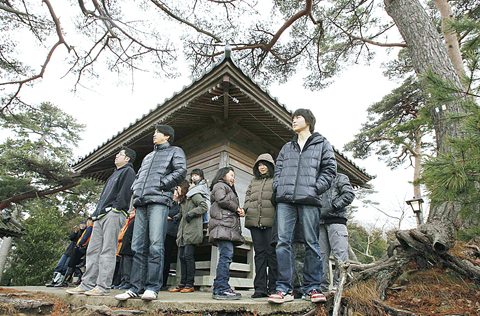Japan imposed a mass tsunami evacuation yesterday but fears of destructive waves churned up by Chile’s killer earthquake ebbed across the Pacific Ocean’s vast “Ring of Fire.”
Evacuation orders forced at least 320,000 people away from areas on Japan’s east coast as oceanic surges up to 1.2m high slammed ashore. Swells from the roiling sea flooded buildings in several ports.
“Please do not approach the coast at any cost,” Japanese Prime Minister Yukio Hatoyama warned in a nationally televised address as residents were shepherded to schools and other public facilities beyond the low-lying danger zone.

PHOTO: REUTERS
However, Japan later downgraded its alert and Russia cancelled its own warning after only minor waves reached the Kamchatka peninsula, while dauntless swimmers and surfers in Australia defied official warnings and flocked to the beach.
The Hawaii-based Pacific Tsunami Warning Center lifted its tsunami warning for the entire region. Thousands of people in 19 Philippine provinces who had voluntarily fled were free to return home, officials in Manila said.
Warning sirens had wailed as about 50 countries and territories along an arc stretching from New Zealand to Japan went on alert, five years after the Indian Ocean tsunami disaster that killed more than 220,000 people.
Waves pummeled Chile and rolled through into Hawaii, French Polynesia and the South Pacific as the tsunami moved at jet-speed across the giant ocean after Saturday’s 8.8-magnitude quake, which unofficial tallies say left at least 300 people dead.
Five people were killed on the remote Robinson Crusoe archipelago far off the coast of Chile, the first reported tsunami casualties, but elsewhere no significant damage was reported and surges of water were smaller than expected.
In Japan, one of the world’s most quake-prone nations, authorities were brooking no chances with the mass evacuation. But damage appeared limited, as sea gates in fishing ports slammed shut and boats steamed home.
The Hawaii center, set up by Pacific governments after the 1960 tsunami, had warned of possible “widespread damage” from waves as high as 3m.
In Hawaii itself, the tsunami led to the evacuation of thousands of people and triggered panic buying of food, water and fuel, but there was little damage.
In the island paradise of French Polynesia schools were closed, the port in Papeete was evacuated and thousands in Tahiti’s hillside areas were taken to safety as the tsunami hit.
Waves up to 1.5m high rammed New Zealand’s eastern Chatham Islands. In Australia, the size of the surge dropped to around 40cm although strong currents swelled up the east coast.
Lorentz Engdahl, a regular on Sydney’s Bondi Beach, was one of many to ignore the warnings and take a swim, as hundreds rushed to outlooks along the Australian coast to watch for outsized waves.
“The biggest danger right now are the blue bottles,” Engdahl said, referring to the stinging jellyfish that are a common nuisance on Australian beaches.
People in Tonga and the Cook Islands fled to higher ground, after a South Pacific tsunami killed more than 180 in September.

The CIA has a message for Chinese government officials worried about their place in Chinese President Xi Jinping’s (習近平) government: Come work with us. The agency released two Mandarin-language videos on social media on Thursday inviting disgruntled officials to contact the CIA. The recruitment videos posted on YouTube and X racked up more than 5 million views combined in their first day. The outreach comes as CIA Director John Ratcliffe has vowed to boost the agency’s use of intelligence from human sources and its focus on China, which has recently targeted US officials with its own espionage operations. The videos are “aimed at

STEADFAST FRIEND: The bills encourage increased Taiwan-US engagement and address China’s distortion of UN Resolution 2758 to isolate Taiwan internationally The Presidential Office yesterday thanked the US House of Representatives for unanimously passing two Taiwan-related bills highlighting its solid support for Taiwan’s democracy and global participation, and for deepening bilateral relations. One of the bills, the Taiwan Assurance Implementation Act, requires the US Department of State to periodically review its guidelines for engagement with Taiwan, and report to the US Congress on the guidelines and plans to lift self-imposed limitations on US-Taiwan engagement. The other bill is the Taiwan International Solidarity Act, which clarifies that UN Resolution 2758 does not address the issue of the representation of Taiwan or its people in

US Indo-Pacific Commander Admiral Samuel Paparo on Friday expressed concern over the rate at which China is diversifying its military exercises, the Financial Times (FT) reported on Saturday. “The rates of change on the depth and breadth of their exercises is the one non-linear effect that I’ve seen in the last year that wakes me up at night or keeps me up at night,” Paparo was quoted by FT as saying while attending the annual Sedona Forum at the McCain Institute in Arizona. Paparo also expressed concern over the speed with which China was expanding its military. While the US

SHIFT: Taiwan’s better-than-expected first-quarter GDP and signs of weakness in the US have driven global capital back to emerging markets, the central bank head said The central bank yesterday blamed market speculation for the steep rise in the local currency, and urged exporters and financial institutions to stay calm and stop panic sell-offs to avoid hurting their own profitability. The nation’s top monetary policymaker said that it would step in, if necessary, to maintain order and stability in the foreign exchange market. The remarks came as the NT dollar yesterday closed up NT$0.919 to NT$30.145 against the US dollar in Taipei trading, after rising as high as NT$29.59 in intraday trading. The local currency has surged 5.85 percent against the greenback over the past two sessions, central